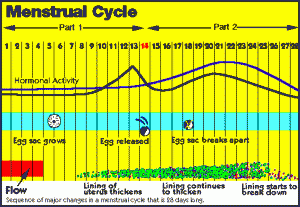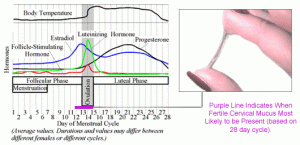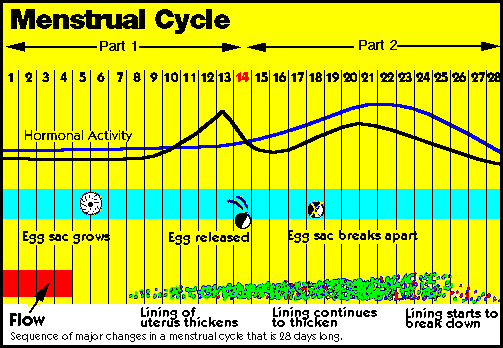For maximum accuracy, follow the kit’s directions to the letter. However, if the instructions say to test your first urine of the day, you may want to test your second catch instead. Your urine can become concentrated overnight and might give you a false-positive result.
Your cycle starts on the first day you have your period. If you have a 28-day cycle, start using the test on day 11 and use it for six days, or however many days the manufacturer recommends. If your cycle runs between 27 and 34 days, your ovulation may range between days 13 and 20. Start testing on day 11 and continue until day 20 or so. If you have an irregular cycle, you may find that this is the least satisfying way for you to detect your ovulation, because some of the kits — which range in price from $20 to $50 — provide only five to nine days’ worth of tests. You may need to buy more than one kit a month.
Charting Your Menstrual Cycle
 Many women choose to chart their menstrual cycle in order to determine when they are ovulating. Ovulation charting is also useful for predicting when your next period will be. All you need is a calendar that marks all the days in each month. When your period comes, mark that day on the calendar. This is known as Day 1. Next month, you will also record the first day of your period on the calendar. Count the number of days in between to find out the length of your cycle. To determine when you ovulate, count back 14 days from Day 1 of your cycle. This method will not be completely accurate it may be a few days off but it should give you a good idea as to when you are ovulating.
Many women choose to chart their menstrual cycle in order to determine when they are ovulating. Ovulation charting is also useful for predicting when your next period will be. All you need is a calendar that marks all the days in each month. When your period comes, mark that day on the calendar. This is known as Day 1. Next month, you will also record the first day of your period on the calendar. Count the number of days in between to find out the length of your cycle. To determine when you ovulate, count back 14 days from Day 1 of your cycle. This method will not be completely accurate it may be a few days off but it should give you a good idea as to when you are ovulating.
Also, some women get ovulation symptoms when their ovulation day is approaching or when ovulation is actually occurring. I will talk about three of the most common ovulation symptoms next to help make ovulation prediction simpler for you.
* Cervical mucus during ovulation and approaching ovulation is one of the signs of ovulation and a great way to know that your most fertile days have arrived. One of the purposes of cervical mucus during ovulation is to sustain the sperm in a healthy medium and to allow it to move freely through the cervix. Logically, as your cycle progresses, your cervical mucus increases in volume and changes texture. The changes reflect your body’s rising levels of estrogen. You are considered most fertile when the mucus becomes clear, slippery, and stretchy. Many women compare mucus at this stage to raw egg whites.
 Normally the mucous is a protective barrier, but during the most fertile time of your cycle, it allows sperm to get through the cervix, up to the uterus, and then to the fallopian tubes for a rendezvous with your egg. Using clean fingers, or if you prefer, toilet paper, you can examine your cervical fluid. Prior to ovulation, during non-fertile periods, you will experience a dryness (or lack of cervical mucus). Gradually, as you approach ovulation, the cervical mucus will increase, though the consistency will be “sticky†and the color will be white, yellow, or cloudy in nature.
Normally the mucous is a protective barrier, but during the most fertile time of your cycle, it allows sperm to get through the cervix, up to the uterus, and then to the fallopian tubes for a rendezvous with your egg. Using clean fingers, or if you prefer, toilet paper, you can examine your cervical fluid. Prior to ovulation, during non-fertile periods, you will experience a dryness (or lack of cervical mucus). Gradually, as you approach ovulation, the cervical mucus will increase, though the consistency will be “sticky†and the color will be white, yellow, or cloudy in nature.
Directly prior to ovulation, cervical fluid will increase greatly, and now the mucus will be semi-transparent, slippery, with the consistency of “raw egg whiteâ€. This is your most fertile period and ovulation will take place at about this time.
Keep track of this and other ovulation symptoms on your ovulation calendar and/or basal body temperature (BBT) chart. The more you track, the clearer you will understand when your most fertile days are and the easier time you will have determining ovulation date. You should begin to see patterns after tracking for a couple months. If you find that your cervical mucus is not reaching the “raw egg white†stage, you may want to try a lubricant like Pre-Seed. Pre-Seed is the only truly sperm friendly lubricant currently on the market at this time, and many people have found success in getting pregnant while using it.
* Another ovulation symptom some women experience is cramping during ovulation or ovulation pain. About one-fifth of women actually feel ovulatory activity, which can range from mild achiness to twinges of pain. This is called mittelschmerz, which means “middle pain” in German, and may last a few minutes to a few hours. Many women experience a cramping-type sensation during ovulation. Sometimes this cramping sensation has felt like trapped stomach gas.
* Many times women will also have light spotting along with the cramping during ovulation. The bleeding during ovulation could be caused by a couple different things. One theory is that the egg bursting forth from the follicle caused the bleeding. Another theory is that the estrogen rise during ovulation caused the uterine lining to shed a bit and cause a little spotting. This along with the cramping sensation is apparently an excellent fertility sign and means you are ovulating good and strong.

